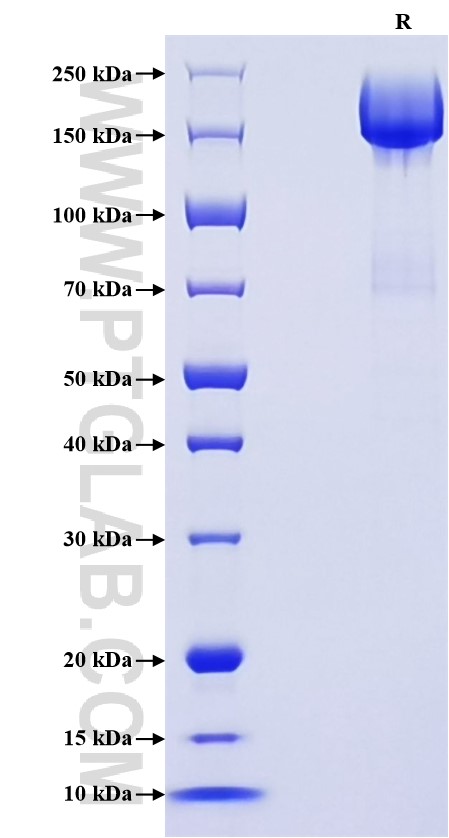Recombinant Mouse L1cam protein (rFc Tag)
种属
Mouse
纯度
>90 %, SDS-PAGE
标签
rFc Tag
生物活性
未测试
验证数据展示
产品信息
| 纯度 | >90 %, SDS-PAGE |
| 内毒素 | <0.1 EU/μg protein, LAL method |
| 生物活性 |
Not tested |
| 来源 | HEK293-derived Mouse L1cam protein Ile20-Glu1123 (Accession# P11627) with a rabbit IgG Fc tag at the C-terminus. |
| 基因ID | 16728 |
| 蛋白编号 | P11627 |
| 预测分子量 | 150.1 kDa |
| SDS-PAGE | 140-250 kDa, reducing (R) conditions |
| 组分 | Lyophilized from 0.22 μm filtered solution in PBS, pH 7.4. Normally 5% trehalose and 5% mannitol are added as protectants before lyophilization. |
| 复溶 | Briefly centrifuge the tube before opening. Reconstitute at 0.1-0.5 mg/mL in sterile water. |
| 储存条件 |
It is recommended that the protein be aliquoted for optimal storage. Avoid repeated freeze-thaw cycles.
|
| 运输条件 | The product is shipped at ambient temperature. Upon receipt, store it immediately at the recommended temperature. |
背景信息
L1cam (the L1 cell adhesion molecule), is the prototype member of the L1-family of closely related neural adhesion molecules. L1cam is a 200–220 kDa transmembrane glycoprotein of the immunoglobulin (Ig) superfamily composed of six Ig-like domains and five fibronectin type III repeats followed by a transmembrane region and a highly conserved cytoplasmic tail. L1cam plays an essential role in the development of the nervous system but it is also highly relevant for the progression of human tumors. L1cam is not expressed in most normal tissues during homeostasis, including in rapidly proliferating tissues such as the intestinal epithelium.
参考文献:
1. Doberstein K, et al. (2015). Mar 1;136(5):E326-39. 2. Kiefel H, et al. (2012). Cell Adh Migr. Jul-Aug;6(4):374-384. 3. Ganesh K, et al. (2020). Nat Cancer. 2020 Jan;1(1):28-45.
